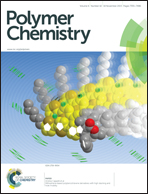A designed synthetic strategy toward poly(isosorbide terephthalate) copolymers: a combination of temporary modification, transesterification, cyclization and polycondensation†
Abstract
A designed synthetic strategy to overcome the low reactivity of isosorbide (Is) and terephthalic acid (TPA) is developed for the preparation of engineering polycondensates. This method contained substitution of unreactive end groups of Is and TPA by reacting with dimethyl carbonate and 1,2-alkanediol or 1,3-alkanediol respectively, followed by transesterification, cyclization of an alkylene carbonate unit, and polycondensation. Is and TPA were temporarily linked by an unstable alkylene carbonate unit and then underwent cyclization with the elimination of five- or six-membered cyclic carbonate at elevated temperature, leading to a family of poly(isosorbide carbonate-co-isosorbide terephthalate)s with high Tg (169–193 °C) and high number-average molecular weights (22 700–28 500 g mol−1). The molecular structure of the copolymer was confirmed using 1H, 13C and 2D NMR techniques. GC-MS, 1H NMR and 13C NMR were used to monitor the molecular structure evolution during the combinatorial polymerization process and a mechanism was proposed. Furthermore, the structure–thermal properties relationship study was also conducted on a range of relevant polyesters.


 Please wait while we load your content...
Please wait while we load your content...